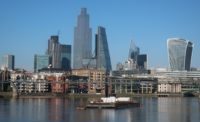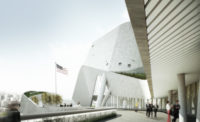As summer ebbed, many U.S. architecture firms were touting how their expansion into foreign markets, which had ramped up in earnest over the last few years, could hedge them against any domestic economic downturn. The reasons? Strong currencies. Non-reliance on foreign trade. Under-housed populations. Robust oil revenue.

How quickly predictions can change. As the financial crisis spreads like a contagion across the globe, markets that once seemed safe are very much less so. Banks’ refusal to lend, and investors’ unwillingness to commit, if they even have the wherewithal to do so, have delayed projects or resulted in their flat-out cancellation, often before architects have put pen to paper.
While some cities appear to be capitalized enough that their projects are on track, the overarching sentiment appears to be gloomy.
“The world has changed dramatically in just two months,” says Julian Anderson, president of Rider Levett Bucknall, a consulting group with 80 international offices that advises governments, schools, and hotel owners, among others. “Some areas are affected less,” he adds, “but there are really no areas that are unaffected, at least not where Western architects would be interested in practicing.”
Architects who work overseas agree that the most dramatic change has come to the Mideast, in particular, to Dubai, where housing prices have plummeted.
Since the end of November, New York’s FXFOWLE, for example, has seen two Dubai projects halted; one is a master plan for a mixed-use community, and the other a trio of high-rise towers, says Steven Miller, FAIA, managing director of the firm’s Dubai office. A two-tower development in Bahrain, too, has been stalled indefinitely, Miller says.
Similarly, Cetra/Ruddy, a New York practice, was “days away” from Dubai commissions for both a hotel and high-end mid-rise apartment building when the plug was recently pulled, says partner John Cetra, AIA. And spooked investors have backed out of several regional hotels being designed by HKS, the Dallas firm, says chairman Ralph Hawkins, FAIA. “We’re seeing hesitation in all the global markets,” he says.
Russia’s development industry also appears to be struggling.
A year ago, Altoon + Porter, a Los Angeles firm behind the first building in the former Soviet Union designed by Western architects—the Atrium, a retail plaza that opened in 2000—had 12 projects lined up, says partner Ronald Altoon, FAIA. Now, just one is being built on-schedule, the Moskva Collection, a mixed-use project that will include apartments for retired generals, plus a three-level 300,000-square-foot retail space, which Altoon is designing.
Three projects have been postponed for at least three months, he says; the other eight have been delayed indefinitely. “I thought Russia was immune to any financial crisis, but that was based on the price of oil not falling below $100 a barrel,” he says. “When it went below $50, everything stopped.” Also, four of five of Altoon’s projects in neighboring Ukraine will not proceed, because of sharp devaluations of its currency, he adds.
Once thought to be immune, India, too, is now stumbling, according to FXFOWLE’s Miller, who says three of his projects have been halted in the last few weeks: a northern India information technology center, a Delhi office building, and Mumbai commercial tower. “The rupee is doing loop de loops and investors aren’t sure what to do with the money, because you can’t easily trade it,” he says.
But not all investors seem spooked by the currency issues, as work proceeds on two of Cetra’s developments in India’s Cochin, including a 13-story marina-side luxury apartment and a 40-story equivalent farther inland, for which he’s handling interiors.
Of course, in business it helps to be an optimist, and architects are quick to point to countries where the confidence of investors, developers, and buyers has been relatively unshaken, thus generating commissions.
Seattle-based Callison, which specializes in retail spaces, has placed bets on Indonesia, which has less speculative construction than other Asian countries, says principal Bill Gartz, AIA. His 100,000-square-foot, four-story Harvey Nichols department store, an Indonesia first, opened on time in Jakarta in November.
HKS’s Hawkins, on the other hand, likes Australia, where there’s demand for healthcare facilities, a sector that appears to do well after a period of commercial growth. His Royal Children’s Hospital, a six-story 1.3 million-square-foot project in Melbourne, is under construction and on schedule, he says. “The demand is coming from a quickly aging population,” Hawkins says.
Yet Steven M. Davis, FAIA, a partner at Davis Brody Bond Aedas, which has 39 international offices, has set his sights on somewhere closer: the U.S., where a rebound could be imminent. “It’s a stronger market than most, and large,” he says, “so we will be looking close to home for a while.”
For more economic news, check out our Recession & Recovery special section.





Post a comment to this article
Report Abusive Comment